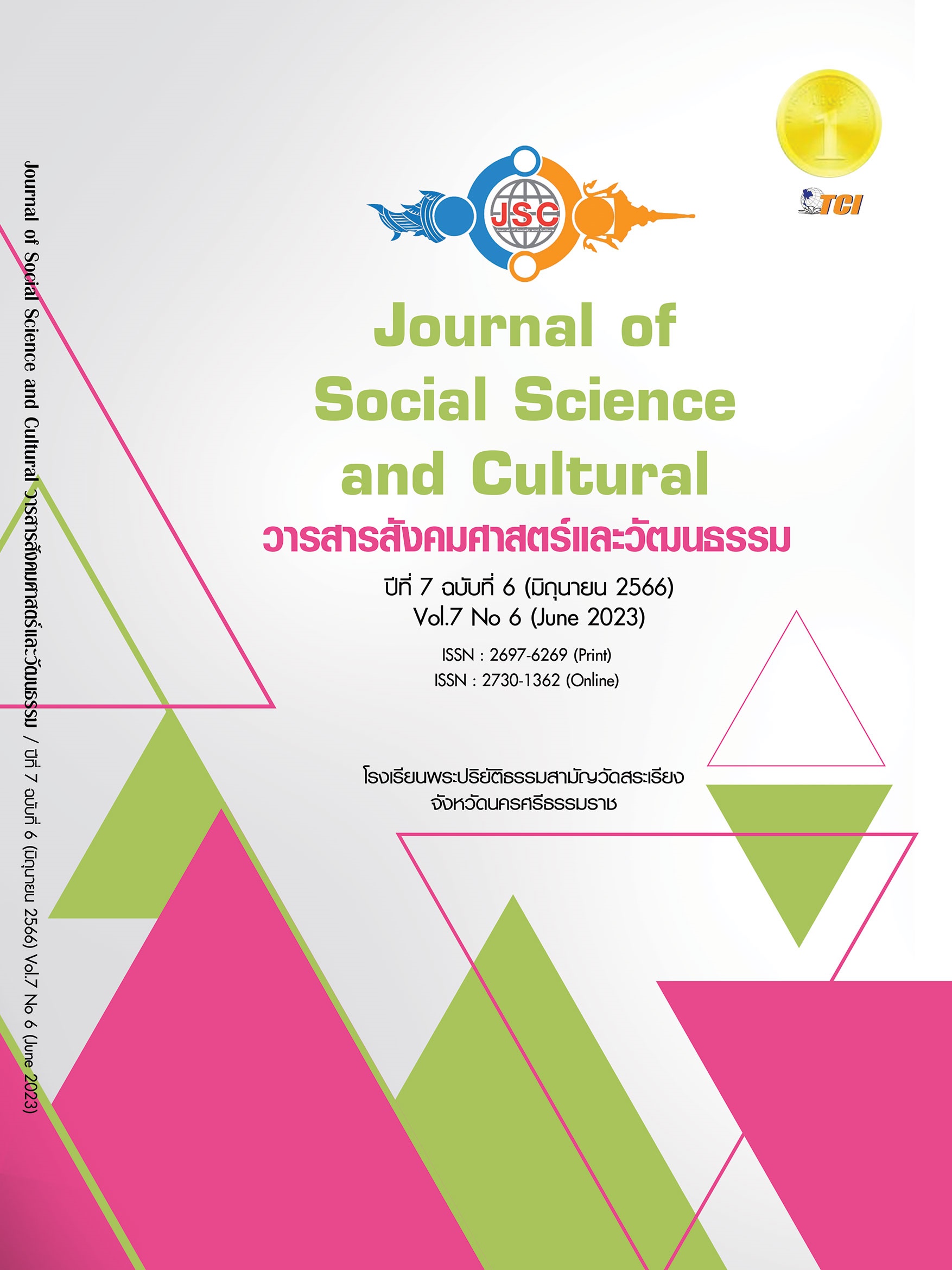CULTURAL CAPITAL MANAGEMENT FOR REGENERATION THE PLANTING OF BETEL LEAF AN MODEL COMMUNITY, SONGKHLA PROVINCE
Main Article Content
Abstract
This research aims to study the cultural capital relating to the betel leaf and the regeneration of betel leaf planting in a model community in Songkhla Province for the existence of an ancestor’s occupation. The researcher used qualitative research and participatory action research in sub-districts of Songkhla Province consisted of Chanong Sub-district, Sanam Chai Sub-district, Tha Kham Sub-district, and Thung Wang Sub-district. The key informants are 60 persons categorized into three groups including 1) betel leaf cultivators, buyers, and retailers 40 persons 2) Leader, sub-district headman, village headman, religious ritual leaders and local scholars 10 persons and 3) Members of Sub-district Administrative Organization, District Agricultural Office and Community Development 10 persons. The research instruments consist of in-depth interviews, structured interviews, public participation, and content analysis. The research discovered that the betel leaf signifies an auspicious plant symbolized luck, happiness, respect, and social status. Moreover, cultural capital and betel leaf relate to the way of life, tradition, belief, value, and economy. Thus, In terms of the regeneration of betel leaf cultivation in the ideal community, Songkhla is as the followings: 1) Building awareness on the worth and value of the betel leaf in both culture and economy toward descendant and new-generation youth 2) Establishing betel leaf learning center to combine prior and new knowledge into the context of change, conduct activities to promote the career, and distribute the knowledge to the public and 3) Founding the career group of betel leaf farming to increase the quantity of betel leaf and strengthen the occupation. The method, according to this study, is the suitable regeneration of betel leaf for communities and the era based on integrated betel culture and learning center under the concept of conservation, inheritance, and enhancement to proceed with the continuous and sustainable regeneration of betel leaf planting in the model community, Songkhla Province.
Article Details
References
กรมพัฒนาที่ดิน. (2564). แนวทางการส่งเสริมการเกษตรที่เหมาะสม จังหวัดสงขลา. เรียกใช้เมื่อ 6 มีนาคม 2565 จาก https://www.ldd.go.th/Agri-Map/Data/S/ska.pdf
กัญญารัตน์ แก้วกมล และคณะ. (2563). การใช้ทุนทางวัฒนธรรมเพื่อการพัฒนาชุมชนอย่างยั่งยืน. วารสารวิชาการมนุษย์ศาสตร์และสังคมศาสตร์, 11(1), 75-91.
การศึกษานอกโรงเรียน. (2560). เยี่ยมแหล่งเรียนรู้การปลูกพืชผสมผสานบ้านพลู. เรียกใช้เมื่อ 19 มีนาคม 2565 จาก http://sk.nfe.go.th/hatyai13/index.php
ขวัญเรือน บุญกอบแก้ว. (2562). แนวทางการปรับใช้ทุนทางวัฒนธรรมในการพัฒนาชุมชนบ้านวังหอน ตำบล วังอ่าง อำเภอชะอวด จังหวัดนครศรีธรรมราช. วารสารมนุษยศาสตร์และสังคมศาสตร์, 10 (ฉบับพิเศษ), 188-209.
คัชพล จั่นเพชร และพิทักษ์ ศิริวงศ์. (2560). การบูรณาการทุนทางวัฒนธรรมสู่การเป็นแหล่งท่องเที่ยวเชิงสร้างสรรค์ด้วยกระบวนการมีส่วนร่วมของชุมชน: กรณีศึกษาชุมชนบ้านชากแง้ว อำเภอบางละมุง จังหวัดชลบุรี. Journal of Community Development Research Humanities and Social Science, 10(1), 111-121.
จีรวรรณ ศรีหนูสุด และวนิษา ติคํา. (2561). วัฒนธรรมหมากและการจัดการหมากของตำบล บางสวรรค์ อำเภอพระแสง จังหวัดสุราษฎร์ธานี. วารสารมนุษย์และสังคมศาสตร์, 10(2), 317-352.
ชนิตร์นันท์ สุริยวิทยาเวช. (2562). จากยุทธศาสตร์ 20 ปีสู่ แผนแม่บทแห่งชาติว่าด้วยการพัฒนาสมุนไพร ไทย ด้วยการบูรณาการการศึกษาเกษตร. วารสารครุศาสตร์อุตสาหกรรม, 18(1), 240- 250.
ชวดี โกศล. (2561). การบริหารจัดการทุนทางวัฒนธรรมของกลุ่มชาติพันธุ์ ในเขตพื้นที่ภาคเหนือ ของประเทศไทย. ใน ดุษฎีนิพนธ์ปรัชญาดุษฎีบัณฑิต สาขาวิชารัฐประศาสนศาสตร์ บัณฑิตวิทยาลัย . มหาวิทยาลัยรังสิต.
นิภาวรรณ์ เจริญลักษณ์ และคณะ. (2561). การศึกษาภูมิปัญญาและการอนุรักษ์ ฟื้นฟูวิถีชีวิตชาวสวนส้มโอลุ่มแม่น้ำนครชัยศรี. สักทอง. วารสารมนุษย์ศาสตร์และสังคมศาสตร์ (สทมส.), 24(1), 181-198.
เปรมชัย จันทร์จำปา. (2558). การจัดการทุนทางวัฒนธรรมเพื่อการพัฒนาเมื่อในเขตเทศบาลนคร สงขลา. ใน วิทยานิพนธ์ปริญญามหาบัณฑิต สาขาบริหารรัฐกิจ. มหาวิทยาลัยธรรมศาสตร์.
วาสนา อาจสาลิกรณ์ และคณะ. (2563). ทุนทางวัฒนธรรมกับการส่งเสริมศักยภาพชุมชนท่องเที่ยว OTOP นวัตวิถีไทยดำ บ้านวังน้ำ ตำบลวังยาง อำเภอคลองขลุง จังหวัดกำแพงเพชร. วารสารพิกุล, 18(2), 269-287.
ศูนย์ข่าวหาดใหญ่. (2560). ชาวทุ่งหวังปลูกพลูอินโดนีเซียสร้างรายได้เสริม ส่งออกต่างประเทศ. เรียกใช้เมื่อ 22 มีนาคม 2565 จาก https://mgronline.com/south/detail/9600000033372
สำนักงานคณะกรรมการพัฒนาการเศรษฐกิจและสังคมแห่งชาติ. (2562). ยุทธศาสตร์ชาติระยะ 20 ปี (พ.ศ. 2560-2579) (พิมพ์ครั้งที่ 2). กรุงเทพมหานคร: สำนักงานเลขานุการของคณะกรรมการ ยุทธศาสตร์ชาติ สำนักงานคณะกรรมการพัฒนาการเศรษฐกิจและสังคมแห่งชาติ.
สุธิดา พฤกษ์อุดม. (2563). จังหวัดสงขลา ส่งเสริมการพัฒนาสมุนไพรแบบครบวงจร รองรับโครงการพัฒนาเมืองสมุนไพร (Herbal City). เรียกใช้เมื่อ 14 มีนาคม 2565 จาก https://thainews.prd.go.th/th/news/detail/TCATG200811112619814
สุพิชฌาย จินดาวัฒนภูมิ. (2561). วัฒนธรรมการกินหมากในสังคมไทยสมัยก่อน. ใน วิรัตน์ ปิ่นแก้ว (ประธาน), งานประชุมวิชาการระดับชาติ (ครั้งที่ 10). มหาวิทยาลัยราชภัฏนครปฐม: นครปฐม.
โสพิศ โพธิสุวรรณ. (2543). การศึกษาเปรียบเทียบวัฒนธรรมการทำสวนพลูปากหรามกับพลูวังโหลจังหวัดนครศรีธรรมราช. ใน วิทยานิพนธ์ปริญญามหาบัณฑิต. มหาวิทยาลัยทักษิณ.
อัญธิชา มั่นคง. (2560). บทบาทของทุนทางวัฒนธรรมกับการพัฒนาเศรษฐกิจ ชุมชน กรณีศึกษาชุมชนในตำบลบ้านตุ่น อำเภอเมือง จังหวัดพะเยา. วารสารวิจัยและพัฒนา มหาวิทยาลัยราชภัฏเลย, 12(39), 90-100.
อุทิศ ทาหอม และสุนันท์ เสนารัตน์. (2561). แนวทางการเพิ่มมูลค่าทางเศรษฐกิจสินค้าทางวัฒนธรรมขนมทองม้วนของกลุ่มวิสาหกิจชุมชนบ้านยาง ตําาบลบ้านยาง อําเภอเมือง จังหวัดบุรีรัมย์. วารสารวิจัยและพัฒนา มหาวิทยาลัยราชภัฏบุรีรัมย์, 14(1), 7-25.


